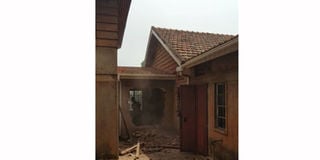Break, add and build: Rules for altering a building

It may cost less to expand on the ground rather to add a storey/pHOTO/file
What you need to know:
Have new ideas for breaking and expanding your building? Here are some rules and safety requirements you need to fulfill.
Often, our needs supersede our house space and the necessity to create more space becomes undeniable. For example, if your bungalow cannot accommodate all your family needs, you may desire to build upwards. In such cases, the building’s original plan must be altered.
Here are some things you ought to know or do before you make any modifications:
Get a consultant
When making alterations, Architect Ambrose Kajubi of KHC Architects says: “Working with a consultant is very important because it is never smooth sailing when modifications are being done. For example, you will bump into several uncertainties such as bats in the ceiling, a crack, water damage in the ceiling or anywhere else in the building. In such cases, a consultant will advise on how to proceed.” He says the consultant does not have to be on the site all the time owing to the cost implication, but should make some supervisory visits.
The architect should be one with whom the client can easily communicate their wishes in a one-on-one discussion. “The architect should also openly advise the client on several issues such as if modifying the building upwards is the best option, if it is viable or adding an extension might be better, if it makes sense economically.”
From the designer’s point of view, Kajubi says some modifications improve the aesthetics of a building while others make it look hideous. “At this point, the consultant will be showing you some sketches to see what works and what does not. You will also discuss the roof considerations depending on whether the modifications are taking up an entire floor,” he says.
In summary, these bits of advice are given on the basis that the client has a clear and concise picture of the modifications they desire to make.
Preliminary checks
Kajubi says the consultant will then do some preliminary checks on the building. “These checks involve finding out if the building can accommodate an extra floor; whether the existing walls can take on extra weight, possibility of adding access to the upper floor, and if the amount of room required can fit in the available space – one might need several rooms on that upper floor yet there is not enough space—and if the existing electrical wiring and plumbing can be matched with new ones,” says Kajubi.
Lawrence Simiyu, a contractor, adds that if the building was built with a stretcher bond, it would not be advisable to add a floor above because those walls cannot carry any load above. “If they have used blocks, it is more reassuring if they are solid rather than hollow with a span of not less than six inches. Mud bricks cannot carry much load. However, burnt clay bricks built in a header bond can work,” he says.
Simiyu adds that there is need to look at the distance between walls on the side of the bungalow on which one wants to add a storey.
“If the walls are not so far apart- three metres apart; all around, it makes it easy as one will just introduce beams around then cast a slab because the span is not so wide apart. However, if the rooms below are say, 4.5 or five metres apart, columns must be introduced, walls broken and the foundation excavated. If the client agrees to it, that is fine, but it comes with a high cost. That said, the building will be structurally sound to carry the extra floor,” explains Simiyu.
Architect Kajubi says structural integrity tests should be done to see if the building is sound.
“The assessment is also important to see if some of the walls can be broken to create ways without causing any catastrophic damage to the building,” he says.
He adds that in certain circumstances, geotechnical tests are needed to find out if the ground can carry an extra floor.
Creating a design: After all the deliberations, the consultant will come up with a design in line with the planning guidelines that govern modifications.
“These designs are the architectural plans that are in line with what has been agreed upon,” Kajubi shares.
Getting approval: The client needs to get approval for these modifications and he says that requires the consultant to submit these new plans to the planning council overlaid on the existing plans alongside the structural integrity drawings and structural drawings. “There is need to also factor in the public planning inspections as well as the cost of the work to be done,” adds Kajubi.
Daniel Nuwabine Muhumuza, the public relations officer of KCCA, says once the documents needed for modification are ready, they should be dropped off at the Physical Planning client care centre. Assessment fees are payable in the bank.
“For every storey one adds to their building, Shs75, 000 plus 18 per cent VAT is charged. There is also an alteration fee of Shs100, 000 plus 18 per cent VAT though it only applies if the alterations are being done on approved plans,” he says.
Every development attracts a development fee of Shs100, 000 and Shs150, 000 plus 18 per cent VAT for residential and commercial construction respectively.
This is a one-time fee
Once payment is done and receipts presented, Nuwabine says a site visit is done to ensure that what is on paper tallies with what is on site. This attracts no fees.
“Thereafter, a desk review is done where the planner, environment officer and surveyor review the documents before forwarding them to the structural engineer. It is upon the engineer’s approval that a development permit is issued for the commencement of works,” says Nuwabine
Construction
With approval in hand, the client and consultant will work out a building plan on whether construction will be phased or done at once.
“People tend to ignore budgets but looking at them critically and seeing how to cut them back without compromising your standards is important. For example, the client can look at works they can do by themselves to save money such as painting, removing debris,” adds Kajubi.
Health and Safety
Arch Ambrose Kajubi says as these modifications are being done, the family may have to vacate the premises owing to lots of dirt and dust, hazardous materials, sharp objects, noise and lack of privacy. “It is important to gauge the extent to which your normal lifestyle would be affected so as to make an informed decision. These considerations must be brought to light because the family might need to move out of the house for two months or move to the garage as construction goes on. It also helps to plan for the cost implication, in case of a total move.”





